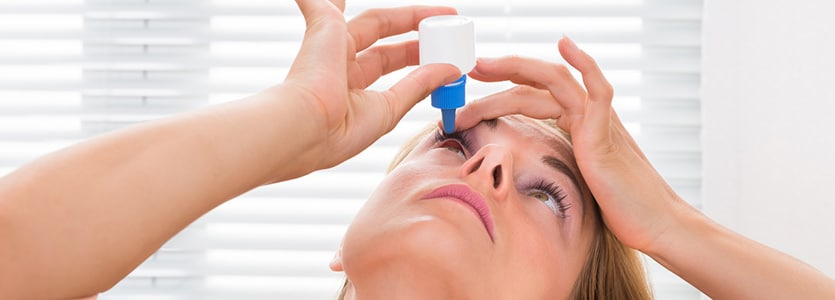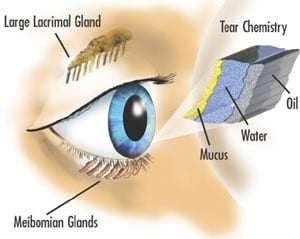
For over fifty years, Hattiesburg Eye Clinic has led the way in South Mississippi offering new, advanced vision treatments. We’re now the first and only clinic in the region to offer OptiLight by Lumenis, an innovative procedure for treating dry eye disease.
What Is Dry Eye?
The name “dry eye” can be a little confusing since one of the most common symptoms involve excessive watering! It makes more sense, though, when you learn that the eye makes two different types of tears.
The first type, called lubricating tears, is produced slowly and steadily throughout the day. Lubricating tears contain a precise balance of mucous, water, oil, nutrient proteins, and antibodies that nourish and protect the front surface of the eye.

The second type of tear, called a reflex tear, does not have much lubricating value. Reflex tears serve as a kind of emergency response to flood the eye when it is suddenly irritated or injured. Reflex tears might occur when you get something in your eye, when you’re cutting onions, when you’re around smoke, or when you accidentally scratch your eye. The reflex tears gush out in such large quantities that the tear drainage system can’t handle them all and they spill out onto your cheek. Still another cause of reflex tearing is irritation of the eye from lack of lubricating tears. If your eye is not producing enough lubricating tears, you have dry eye. For more information on dry eye syndrome or to schedule a consultation, please call our toll-free number 800-624-8254 today!
What Are The Symptoms Of Dry Eye Syndrome?
- Watery eyes
- The feeling that there’s sand in your eyes
- Eyes that itch and burn
- Vision that becomes blurred after periods of reading, watching TV, or using a computer
- Red, irritated eyes that produce a mucus discharge
What Are The Causes Of Dry Eye Disease?
- Age: As we get older, glands in the eyelid produce less oil. Oil keeps tears from evaporating off the eye. Decreased oil production allows tears to evaporate too quickly, leaving the eye too dry.
- Diseases including diabetes, Sjogren’s and Parkinson’s
- Hormonal changes, especially after menopause
- Prescription medications: These include some high blood pressure medications, antihistamines, diuretics, antidepressants, anti-anxiety pills, sleeping pills and pain medications. Over-the-counter medications including some cold and allergy products, motion sickness remedies, and sleep aids can also cause dry eye.
- Hot dry or windy conditions: High altitude, air-conditioning and smoke can also cause dry eye.
- Reading, using a computer or watching TV
- Contact lenses
- Eye surgery: Some types of eye surgery, including iLASIK can aggravate dry eye.
- Inflammation: Recent research suggests that dry eye may be caused by inflammation due to an imbalance of “good” fats and “bad” fats.
How Is Dry Eye Diagnosed?
Your eye doctor can check for dry eye by examining your eyes with magnifying instruments, measuring your rate of tear production and checking the amount of time it takes for tears to evaporate between blinks. The doctor can also check for pinpoint scratches on the front surface of the eye caused by dryness using special, colored eyedrops call fluorescein or Rose Bengal.
What Treatment Options Are Available For Dry Eye?
OptiLight by Lumenis:
OptiLight® by Lumenis is the newest dry eye treatment offered by Hattiesburg Eye Clinic. An OptiLight device generates light pulses directed to the skin below the eyes to improve tear production and slow evaporation. Hattiesburg Eye is the first and only provider in the region to offer this FDA-approved, non-invasive treatment.
Punctal Occlusion:
Punctal occlusion is a medical treatment for dry eye that may enable your eyes to make better and longer use of the few lubricating tears they do produce.
Artificial Teardrops:
Artificial teardrops are the most common form of dry eye treatment, and help make up for the lack of natural lubricating tears. Artificial tear products come in liquid form, longer lasting gelform and long-lasting ointment form, which is most often recommended for nighttime use. Many different brands of artificial tears are available over-the-counter. Some contain preservatives and some do not. Unpreserved tears may be recommended for people whose eyes are sensitive to preservatives. Artificial tears can generally be used as often as needed, from a few times per day to every few minutes. You should follow the regimen your doctor recommends.
When infection, inflammation of the eyelids or clogged oil glands contribute to dry eye, special lid cleaning techniques or antibiotics may be recommended. It may also help to avoid hot, dry or windy environments or to humidify the air in your home or office.
Topical Medicines:
Restasis® and Xiidra® help reduce inflammation, which in turn helps the eyes
produce more tears. Unlike artificial tears, which temporarily relieve dry eye
symptoms, these prescription medications can actually address certain causes for
dry eye disease and reduce symptoms. Restasis is the first drug proven to
effectively treat a cause of Dry Eye Disease rather than only temporarily alleviate
symptoms.
Nasal Spray:
A daily-use nose spray called Tyrvaya® offers another option for relieving dry eye.
One spray in each nostril twice a day stimulates the eyes (by way of the nose) to
generate more natural tears. Research studies involving hundreds of people have
shown the prescription nose spray often begins working after just one dose.
Get In Touch With Us:
To learn more about Hattiesburg Eye Clinic and our services please call us at 601-268-5910 or toll-free at 800-624-8254 or schedule a consultation.


